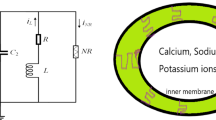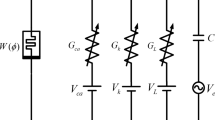Abstract
One-layer membrane separates the gradient field in and out of the cell, while some two-layer membranes filled with excitable media/material are important to regulate the energy flow when ions are propagated and diffused. The intracellular and extracellular media can be effectively separated by the membrane. It is important to clarify and describe the biophysical function and then the capacitive property can be reproduced in equivalent neural circuit. Here, we suggest the cell membrane has certain thickness and becomes flexible under external stimuli, therefore, it is considered as a kind of nonlinear media. To mimic the physical property of the two-layer cell membrane, a nonlinear resistor is used to connect two linear circuits, which is used to describe the electrical characteristic of two sides of the cell membrane, respectively. The combination of two linear circuits via a nonlinear resistor can describe the energy characteristic and firing mode in the flexible membrane of biophysical neurons. Circuit equations are defined and converted into equivalent nonlinear oscillator like a neuron. The voltage difference for the two capacitors can be consistent with the membrane potential for the neuron. The Hamilton energy function for this neuron can be mapped from the field energy in the electronic components, and it is also derived by using Helmholtz’s theorem. The neuron can show similar spiking and bursting firing patterns, and uncertain diversity in membrane potentials is effective to support continuous firing patterns and mode transition under external stimulus. Furthermore, noisy disturbance is applied to induce coherence resonance. The results indicate that the lower coefficient variability and higher average energy level supports periodic firing in the neuron under coherence resonance. Therefore, this neuron model with nonlinear membranes (or two-layer form) is more suitable for identifying the biophysical property of biological neuron.

















Similar content being viewed by others
Data availability
The data are available from the corresponding author upon reasonable request.
References
Arp TB, Pleskot D, Aji V et al (2019) Electron–hole liquid in a van der Waals heterostructure photocell at room temperature. Nat Photonics 13:245–250
Azangue AB, Ngouonkadi EBM, Nono MK et al (2023) Collective behavior in neuronal networks with electrical and hybrid synapses: frequency responses of oscillations. Int J Bifurc Chaos 33:2330005
Banerjee A, Lesser O, Rahman MA et al (2023) Local and nonlocal transport spectroscopy in planar Josephson junctions. Phys Rev Lett 130:096202
Baumgartner C, Fuchs L, Costa A et al (2022) Supercurrent rectification and magnetochiral effects in symmetric Josephson junctions. Nat Nanotechnol 17:39–44
Chen ZQ, Tang H, Wang ZL et al (2015) Design and circuit implementation for a novel charge-controlled chaotic memristor system. J Appl Anal Comput 5:251–261
Corinto F, Forti M (2017) Complex dynamics in arrays of memristor oscillators via the flux–charge method. IEEE Trans Circuits Syst I Regul Pap 65:1040–1050
Creatore C, Parker MA, Emmott S et al (2013) Efficient biologically inspired photocell enhanced by delocalized quantum states. Phys Rev Lett 111:253601
Ding X, Jia B, Li Y et al (2021) Enhancement of coherence resonance induced by inhibitory autapse in Hodgkin-Huxley model. Int J Mod Phys B 35:2150110
Fatemeh P, Mahtab M, Karthikeyan R et al (2022) Synchronization in Hindmarsh–Rose neurons subject to higher-order interactions. Chaos 32:013125
Gilardi-Velázquez HE, Echenausía-Monroy JL, Jaimes-Reátegui R et al (2022) Deterministic coherence resonance analysis of coupled chaotic oscillators: fractional approach. Chaos Solitons Fractals 157:111919
Guo Z, Iu HHC, Si G et al (2020) A phasor analysis method for charge-controlled memory elements. Int J Bifurc Chaos 30:2030041
Guo Y, Zhou P, Yao Z et al (2021) Biophysical mechanism of signal encoding in an auditory neuron. Nonlinear Dyn 105:3603–3614
Isah A, Nguetcho AST, Binczak S et al (2020) Dynamics of a charge-controlled memristor in master–slave coupling. Electron Lett 56:211–213
Janů P, Bajer J, Dyčka P et al (2021) Precise experimental determination of electrical equivalent circuit parameters for ultrasonic piezoelectric ceramic transducers from their measured characteristics. Ultrasonics 112:106341
Jia Y, Gu H, Li Y et al (2021) Inhibitory autapses enhance coherence resonance of a neuronal network. Commun Nonlinear Sci Numer Simul 95:105643
Kang Y, Liu R, Mao X (2021) Aperiodic stochastic resonance in neural information processing with Gaussian colored noise. Cogn Neurodyn 15:517–532
Li L, Zhao Z (2022) White-noise-induced double coherence resonances in reduced Hodgkin–Huxley neuron model near subcritical Hopf bifurcation. Phys Rev E 105:034408
Liu S, Lin S (2009) The analysis of the electro-mechanical model of the cylindrical radial composite piezoelectric ceramic transducer. Sens Actuators A Phys 155:175–180
Ma X, Xu Y (2022) Taming the hybrid synapse under energy balance between neurons. Chaos Solitons Fractals 159:112149
Majhi S, Perc M, Ghosh D (2022) Dynamics on higher-order networks: a review. J R Soc Interface 19:20220043
Mohan NM, Kumar VJ, Sankaran P (2010) Linearizing dual-slope digital converter suitable for a thermistor. IEEE Trans Instrum Meas 60:1515–1521
Oresanya BO, Si G, Guo Z et al (2021) Mathematical analysis and emulation of the fractional-order cubic flux-controlled memristor. Alex Eng J 60:4315–4324
Palabas T, Torres JJ, Perc M et al (2023) Double stochastic resonance in neuronal dynamics due to astrocytes. Chaos Solitons Fractals 168:113140
Radziemska E, Klugmann E (2002) Thermally affected parameters of the current–voltage characteristics of silicon photocell. Energy Convers Manag 43:1889–1900
Raj N, Ranjan RK, Khateb F (2020) Flux-controlled memristor emulator and its experimental results. IEEE Trans Very Large Scale Integr Syst 28(4):1050–1061
Schilling A, Tziridis K, Schulze H et al (2021) The stochastic resonance model of auditory perception: a unified explanation of tinnitus development, Zwicker tone illusion, and residual inhibition. Prog Brain Res 262:139–157
Shin H, Ahn H, Han DY (2005) Modeling and analysis of multilayer piezoelectric transformer. Mater Chem Phys 92:616–620
Slomovitz D, Joskowicz J (1990) Error evaluation of thermistor linearizing circuits. Meas Sci Technol 1:1280
Sun G, Yang F, Ren G et al (2023) Energy encoding in a biophysical neuron and adaptive energy balance under field coupling. Chaos Solitons Fractals 169:113230
Trahms M, Melischek L, Steiner JF et al (2023) Diode effect in Josephson junctions with a single magnetic atom. Nature 615:628–633
Wai RJ, Su KH (2006) Supervisory control for linear piezoelectric ceramic motor drive using genetic algorithm. IEEE Trans Industr Electron 53:657–673
Wang Z, Li Y, Xu Y et al (2022a) Coherence-resonance chimeras in coupled HR neurons with alpha-stable Lévy noise. J Stat Mech: Theory Exp 2022:053501
Wang G, Wu Y, Xiao F et al (2022b) Non-Gaussian noise and autapse-induced inverse stochastic resonance in bistable Izhikevich neural system under electromagnetic induction. Physica A 598:127274
Wang C, Sun G, Yang F et al (2022c) Capacitive coupling memristive systems for energy balance. AEU Int J Electron Commun 153:154280
Wang Y, Sun G, Ren G (2023) Diffusive field coupling-induced synchronization between neural circuits under energy balance. Chin Phys B 32:040504
Xie Y, Yao Z, Hu X et al (2021) Enhance sensitivity to illumination and synchronization in light-dependent neurons. Chin Phys B 30:120510
Xie Y, Yao Z, Ma J (2022) Phase synchronization and energy balance between neurons. Front Inf Technol Electron Eng 23:1407–1420
Xie Y, Zhou P, Ma J (2023a) Energy balance and synchronization via inductive-coupling in functional neural circuits. Appl Math Model 113:175–187
Xie Y, Yao Z, Ma J (2023b) Formation of local heterogeneity under energy collection in neural networks. Sci China Technol Sci 66:439–455
Xu Y, Ma J (2022) Pattern formation in a thermosensitive neural network. Commun Nonlinear Sci Numer Simul 111:106426
Xu Y, Jia Y, Ma J et al (2018) Collective responses in electrical activities of neurons under field coupling. Sci Rep 8(1):1349
Yamakou ME, Inack EM (2023) Coherence resonance and stochastic synchronization in a small-world neural network: an interplay in the presence of spike-timing-dependent plasticity. Nonlinear Dyn 111:7789–7805
Yang F, Ma J (2022) Synchronization and energy balance of star network composed of photosensitive neurons. Eur Phys J Spec Top 231:4025–4035
Yang F, Ma J (2023a) A controllable photosensitive neuron model and its application. Opt Laser Technol 163:109335
Yang F, Ma J (2023b) Creation of memristive synapse connection to neurons for keeping energy balance. Pramana J Phys 97:55
Yang F, Ma J, An X (2022) Mode selection and stability of attractors in Chua circuit driven by piezoelectric sources. Chaos Solitons Fractals 162:112450
Yang F, Wang Y, Ma J (2023) Creation of heterogeneity or defects in a memristive neural network under energy flow. Commun Nonlinear Sci Numer Simul 119:107127
Yang F, Xu Y, Ma J (2023) A memristive neuron and its adaptability to external electric field. Chaos Interdiscip J Nonlinear Sci 33:023110
Yao Z, Wang C (2021) Control the collective behaviors in a functional neural network. Chaos Solitons Fractals 152:111361
Yao Z, Zhou P, Zhu Z et al (2021) Phase synchronization between a light-dependent neuron and a thermosensitive neuron. Neurocomputing 423:518–534
Zhang X, Ma J (2021) Wave filtering and firing modes in a light-sensitive neural circuit. J Zhejiang Univ Sci A 9:707–720
Zhang X, Wang C, Ma J et al (2020a) Control and synchronization in nonlinear circuits by using a thermistor. Mod Phys Lett B 34:2050267
Zhang Y, Xu Y, Yao Z et al (2020b) A feasible neuron for estimating the magnetic field effect. Nonlinear Dyn 102:1849–1867
Zhou P, Yao Z, Ma J et al (2021) A piezoelectric sensing neuron and resonance synchronization between auditory neurons under stimulus. Chaos Solitons Fractals 145:110751
Zhou P, Zhang X, Ma J (2022) How to wake up the electric synapse coupling between neurons? Nonlinear Dyn 108(2):1681–1695
Acknowledgements
This project is supported by the National Natural Science Foundation of China under Grant No. 12072139.
Author information
Authors and Affiliations
Corresponding author
Ethics declarations
Conflict of interest
The authors declare that they have no conflict of interest with this publication.
Additional information
Publisher's Note
Springer Nature remains neutral with regard to jurisdictional claims in published maps and institutional affiliations.
Rights and permissions
Springer Nature or its licensor (e.g. a society or other partner) holds exclusive rights to this article under a publishing agreement with the author(s) or other rightsholder(s); author self-archiving of the accepted manuscript version of this article is solely governed by the terms of such publishing agreement and applicable law.
About this article
Cite this article
Yang, F., Guo, Q. & Ma, J. A neuron model with nonlinear membranes. Cogn Neurodyn 18, 673–684 (2024). https://doi.org/10.1007/s11571-023-10017-5
Received:
Revised:
Accepted:
Published:
Issue Date:
DOI: https://doi.org/10.1007/s11571-023-10017-5




